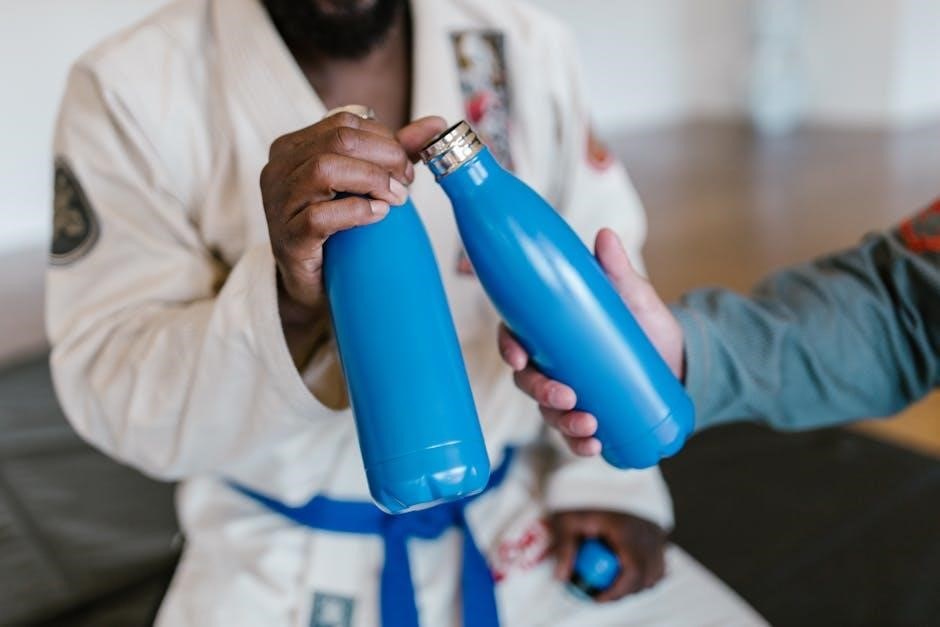
jiu jitsu belt size guide
Discover the essential guide to choosing the perfect Jiu Jitsu belt size, ensuring proper fit, appearance, and rank accuracy for optimal training and performance in BJJ.
1.1 Understanding the Importance of Proper Belt Size
Proper belt size is crucial for both performance and safety in Jiu Jitsu. A correctly fitting belt ensures secure knotting, preventing it from coming undone during training or competition. It also represents rank accurately, maintaining respect for the tradition and hierarchy of the sport. An ill-fitting belt can restrict movement or cause discomfort, hindering technique execution. Additionally, official regulations, such as those from the IBJJF, specify standards for belt width and length, making proper sizing essential for compliance. Choosing the right size enhances training efficiency and adherence to martial arts etiquette.
1.2 Overview of the Belt Ranking System in Jiu Jitsu
The Jiu Jitsu belt ranking system is a hierarchical structure reflecting a practitioner’s skill level and experience. Starting with a white belt, students progress through blue, purple, brown, and eventually black belts, each with degrees indicated by stripes; This system ensures a clear path for advancement, emphasizing mastery of techniques and time invested. Understanding this structure helps practitioners set goals and track their martial arts journey effectively, while also maintaining tradition and respect within the discipline.
Factors Influencing Jiu Jitsu Belt Size
Waist measurement, GI size, and material thickness are key factors influencing belt size, ensuring proper fit and comfort during training and competition in Jiu Jitsu.
2.1 Waist Measurement and Its Role in Belt Sizing
Waist measurement is crucial for determining Jiu Jitsu belt size. Measure your natural waistline, typically around the narrowest point above the hips. This measurement helps ensure the belt fits comfortably and securely. A proper fit prevents slippage during training. For most practitioners, belt length is calculated by doubling the waist circumference and adding 110-120cm for knotting. Accurate measurement ensures optimal performance and compliance with IBJJF standards, which emphasize proper fit for both functionality and appearance.
2.2 Correlation Between GI Size and Belt Size
Your Jiu Jitsu belt size often aligns with your GI size, as both are designed to fit your body proportions. For example, an A1 GI typically corresponds to a belt length of 98 inches. This consistency ensures the belt sits comfortably and securely around your waist, preventing slippage during training. Proper sizing also adheres to IBJJF standards, which require belts to be 4-5 cm wide and have ends that hang evenly when knotted. Matching your GI and belt sizes ensures a seamless fit for optimal performance.
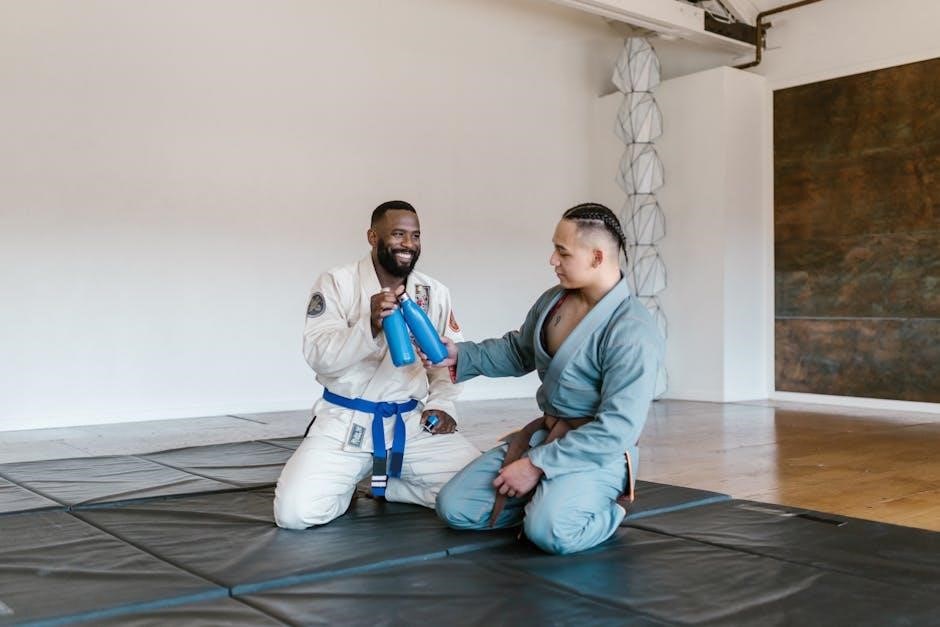
How to Measure for the Correct Belt Size
Measure your natural waistline with a flexible tape measure, ensuring a snug fit without tightening. This provides the accurate circumference needed to determine your ideal belt length.
3.1 Step-by-Step Guide to Measuring Your Waist
To ensure an accurate Jiu Jitsu belt size, measure your waist correctly. Locate your natural waistline, typically just above the hipbone. Wrap a flexible tape measure snugly around this area without tightening. Keep the tape level and parallel to the floor. Note the circumference in centimeters or inches. Avoid measuring over thick clothing, as this may lead to inaccuracies. Record the measurement carefully to determine your ideal belt length for a proper fit.
3.2 Using Waist Measurement to Determine Belt Length
Once you have your waist measurement, use it to calculate your ideal belt length. A standard formula is to double your waist circumference and add 110-120cm for knotting. For example, a 30-inch waist results in a belt length of approximately 80-82 inches. This ensures the belt is long enough to wrap comfortably around your GI and tie securely. Always refer to the manufacturer’s sizing chart for precise measurements, as slight variations may exist between brands. Proper length ensures a secure and comfortable fit during training.
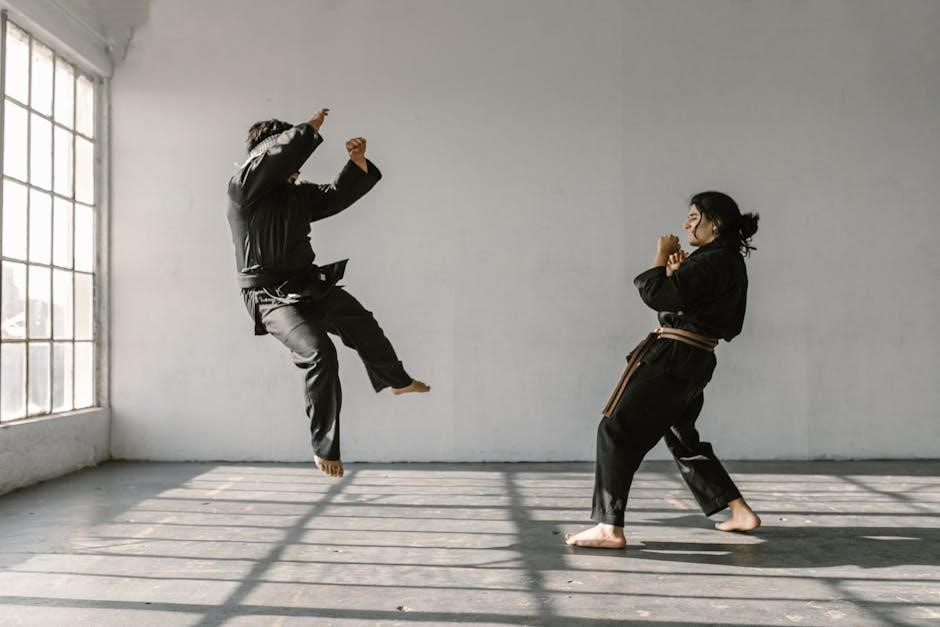
Calculating the Ideal Belt Length
Calculate your belt length by doubling your waist measurement and adding 110-120cm for knotting. This ensures a comfortable, secure fit during training and competition.
4.1 Formula for Belt Length Based on Waist Circumference
The ideal belt length is calculated by measuring your waist circumference, doubling it, and adding 110-120cm for knotting and adjustments. For example, if your waist is 80cm, your belt length would be 80cm x 2 + 115cm = 275cm. This formula ensures the belt is long enough to wrap around your GI securely and allows for a proper double knot. Common waist sizes (A1-A5) correspond to belt lengths ranging from 240cm to 320cm, providing a comfortable and functional fit for all practitioners.
4.2 Adding Extra Length for Knotting and Adjustments
After calculating the base length, add 110-120cm to accommodate knotting and adjustments. This extra length ensures the belt can wrap securely around your GI and tie properly. For example, a 250cm base length becomes 360-370cm total. This allowance prevents the belt from being too tight or slipping during training. Proper knotting and adjustments are crucial for both functionality and meeting competition standards, ensuring a comfortable and secure fit for all practitioners.

IBJJF Guidelines for Belt Size and Appearance
IBJJF guidelines specify that belts must be 4-5 cm wide, with ends hanging 20-30 cm after knotting. Ensure belts meet these standards for competitions and proper appearance.
5.1 Official Belt Width and Length Requirements
The IBJJF mandates that Jiu Jitsu belts must be between 4 to 5 cm in width. Once tied with a double knot, each end of the belt should hang between 20 to 30 cm. Proper measurement ensures the belt fits correctly around the waist, allowing for a secure knot without excess length. Adhering to these guidelines is crucial for both appearance and functionality during training and competitions. Always verify measurements against official standards to maintain compliance.
5.2 Proper Knotting Techniques According to Regulations
The IBJJF requires belts to be tied in a double knot, ensuring each end hangs 20 to 30 cm after knotting. Proper knotting prevents the belt from coming undone during training or competition. The belt must be snug and evenly balanced, with no loose ends exceeding the specified length. Correct knotting ensures compliance with tournament regulations and maintains a professional appearance. Always practice tying your belt to achieve a secure and regulation-compliant knot.
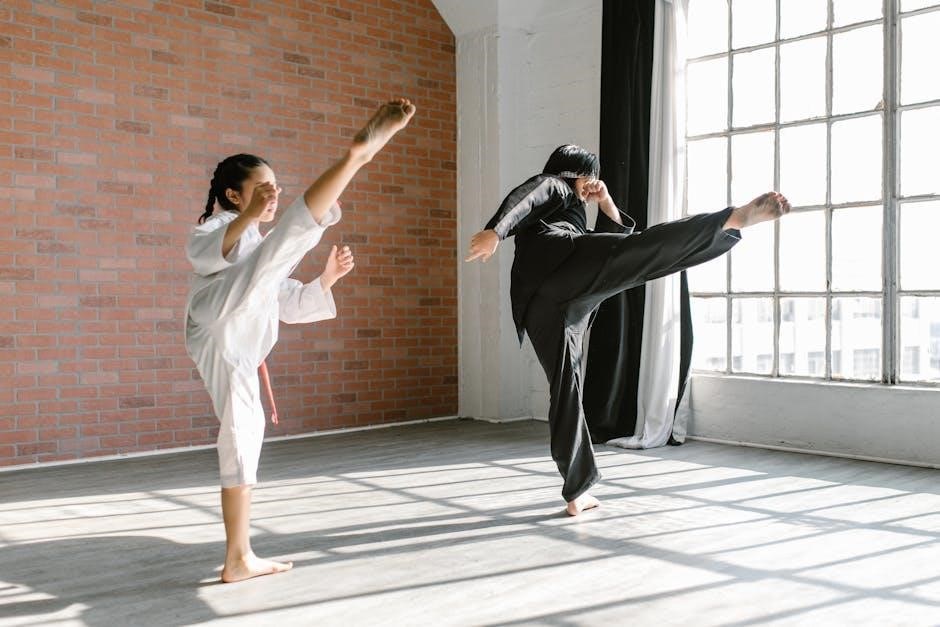
Relationship Between GI and Belt Size
Ensuring your belt size matches your GI size is crucial for proper fit, optimal performance, and meeting competition regulations in Brazilian Jiu-Jitsu.
6.1 Ensuring Consistency Between GI and Belt Measurements
Ensuring consistency between GI and belt measurements is crucial for a proper fit and optimal performance in Jiu Jitsu. Measure your waist to determine your GI size, then select a belt that matches this size. Most manufacturers provide sizing charts to help maintain consistency. Additionally, adhering to IBJJF guidelines ensures your belt meets competition standards, with a width of 4-5 cm and ends hanging 20-30 cm after knotting. Proper sizing prevents discomfort and ensures compliance with regulations during training and competitions.
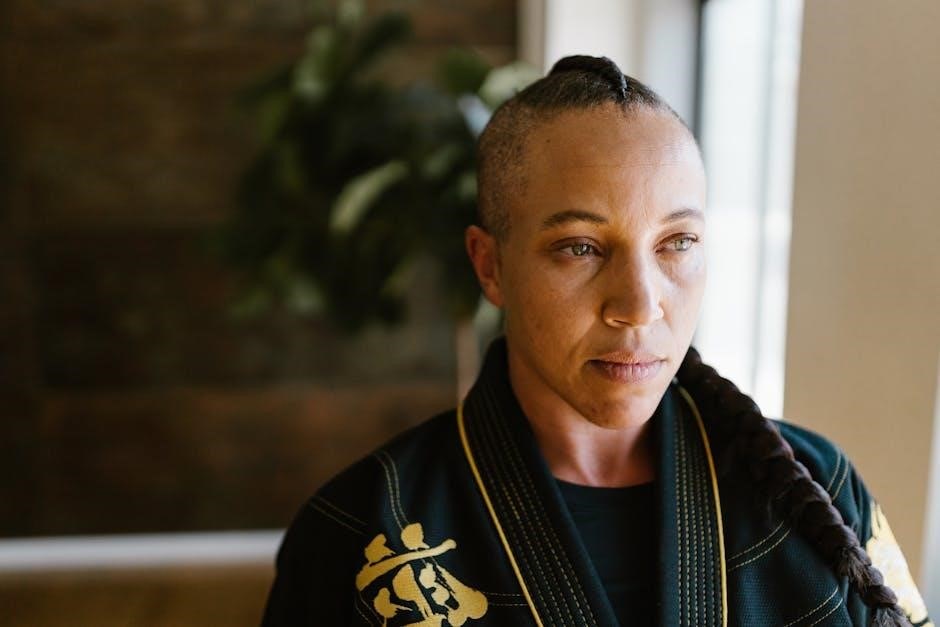
Understanding Belt Colors and Ranks
Jiu Jitsu belts progress through colors like white, blue, purple, brown, and black, each symbolizing skill and dedication. Belt colors align with rank, ensuring consistency in sizing and appearance.
7.1 Progression Through Belt Ranks and corresponding sizes
7.1 Progression Through Belt Ranks and Corresponding Sizes
Brazilian Jiu Jitsu belts progress from white to blue, purple, brown, and black, each representing increased skill and experience. Belt sizes align with practitioner ranks, ensuring proper fit and consistency. As students advance, their belt size typically remains consistent with their GI size, maintaining uniformity in appearance and functionality. Proper sizing supports optimal performance, while stripes on belts denote progress within each rank, reflecting dedication and mastery of techniques.
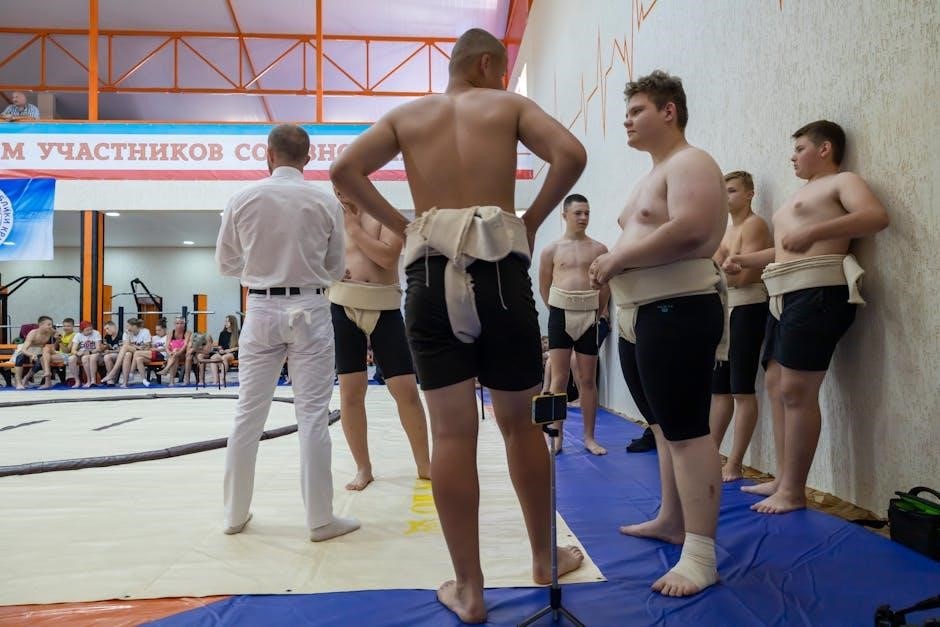
Choosing the Right Belt Material and Thickness
Selecting the right belt material and thickness is crucial for performance. Cotton offers breathability, while synthetic materials enhance durability. Thicker belts provide stability, but may restrict movement.
8.1 Differences in Belt Materials and Their Impact on Sizing
Belt materials vary, influencing size and fit. Cotton belts are breathable but may shrink, requiring a slightly longer initial size. Synthetic belts are durable and less prone to shrinkage, offering consistent sizing. Hybrid materials combine comfort and longevity. Thicker belts provide stability but may feel restrictive. Proper material choice ensures optimal performance and comfort, aligning with personal preference and training demands.
Popular Jiu Jitsu Belt Brands and Their Sizing Charts
Explore top brands like Fuji, Tatami, and Gameness, each offering unique sizing guides to help practitioners choose the perfect belt for their needs and preferences.
9.1 Comparing Size Guides from Leading Manufacturers
Leading brands like Fuji, Tatami, and Gameness offer detailed sizing charts tailored to BJJ needs. Fuji suggests a 99cm belt for A1 GI sizes, while Tatami provides specific length measurements. Gameness offers a straightforward size chart based on waist circumference. Each brand caters to different preferences, ensuring a perfect fit. Comparing these guides helps practitioners choose a belt that aligns with their GI size, personal comfort, and training requirements, making it easier to find the ideal match.
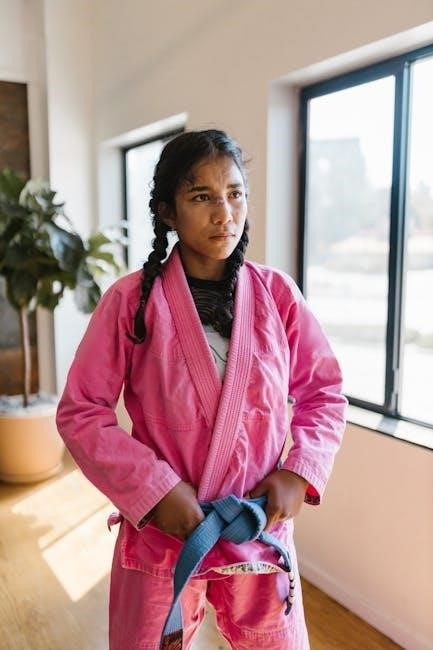
Care and Maintenance of Your Jiu Jitsu Belt
Regularly wash your belt by hand, avoid machine drying, and store it neatly to prevent shrinkage. Cleanliness and proper storage ensure longevity and optimal performance during training.
10.1 Tips to Prevent Shrinkage and Maintain Belt Size
To preserve your Jiu Jitsu belt, wash it by hand with mild soap, avoiding harsh chemicals. Air-dry by laying flat to prevent shrinkage. Store neatly to maintain shape; Regular cleaning prevents odor and extends lifespan. Avoid machine drying and ironing. Proper care ensures your belt remains in optimal condition for years of training.

Common Mistakes in Choosing Belt Size
Common errors include not measuring waist accurately, guessing size instead of calculating, and ignoring shrinkage. Proper measurement ensures the right fit and avoids adjustments during training.
11.1 Avoiding Errors in Measurement and Sizing
To avoid errors, always measure your natural waistline accurately and consider shrinkage. Use a flexible tape measure and ensure it’s level. Double-check calculations using your waist circumference and add extra length for knotting. Avoid guessing sizes based on GI measurements, as belt lengths vary by brand. Refer to manufacturer sizing charts and formulas to ensure accuracy. Improper sizing can lead to a belt that’s too tight or too loose, affecting training performance and appearance. Always verify before purchasing to guarantee the best fit.
The right Jiu Jitsu belt size is crucial for optimal training performance, ensuring proper technique execution and confidence on the mats while meeting regulatory standards.
12.1 How Proper Fit Enhances Training and Performance
A well-fitting Jiu Jitsu belt eliminates distractions during training, allowing focus on technique and movement. It provides the necessary support for secure knotting and proper execution of chokes and holds. A correct fit also boosts confidence, enabling practitioners to perform at their best. Additionally, it ensures compliance with competition standards, avoiding disqualifications. Proper belt fit is essential for both safety and optimal performance in every training session and competition.